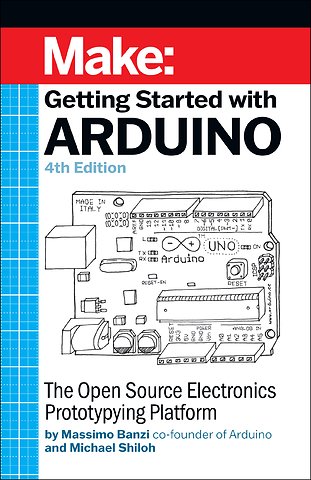Make: Getting Started with Arduino
Paperback Engels 2022 4e druk 9781680456936Samenvatting
Arduino is the open source electronics prototyping platform that has taken the Maker Movement by storm. This thorough introduction, updated for the latest Arduino release, helps you start prototyping right away. From obtaining the required components to putting the final touches on your project, all the information you need is here!
Getting started with Arduino is a snap. To use the introductory examples in this guide, all you need is an Arduino Uno or Leonardo, along with a USB cable and an LED. The easy-to-use, free Arduino development environment runs on Mac, Windows, and Linux.
In Getting Started with Arduino, you'll learn about:
Interaction design and physical computingThe Arduino board and its software environmentBasics of electricity and electronicsPrototyping on a solderless breadboardDrawing a schematic diagramTalking to a computer--and the cloud--from ArduinoBuilding a custom plant-watering system
Specificaties
Lezersrecensies
Inhoudsopgave
Preface
Acknowledgments for Massimo Banzi
Acknowledgments for Michael Shiloh
Conventions Used in This Book
Using Code Examples
O’Reilly Online Learning
How to Contact Us
1. Introduction
Intended Audience
What Is Interaction Design?
What Is Physical Computing?
2. The Arduino Way
Prototyping
Tinkering
We Love Junk!
Hacking Toys
Collaboration
3. The Arduino Platform
The Arduino Hardware
The Software Integrated Development Environment (IDE)
Installing Arduino on Your Computer
Installing the IDE: MacOS
Configuring the Drivers: MacOS
Port Identification: MacOS
Installing the IDE: Windows
Configuring the Drivers: Windows
Port Identification: Windows
Installing the IDE: Linux
Configuring the Drivers: Linux
Granting Permission on the Serial Ports: Linux
4. Really Getting Started with Arduino
Anatomy of an Interactive Device
Sensors and Actuators
Blinking an LED
Pass Me the Parmesan
Arduino Is Not for Quitters
Real Tinkerers Write Comments
The Code, Step by Step
What We Will Be Building
What Is Electricity?
Using a Pushbutton to Control the LED
How Does This Work?
One Circuit, a Thousand Behaviours
5. Advanced Input and Output
Trying Out Other On/Off Sensors
Homemade (DIY) Switches
Controlling Light with PWM
Use a Light Sensor Instead of the Pushbutton
Analogue Input
Try Other Analogue Sensors
Serial Communication
Driving Bigger Loads (Motors, Lamps, and the Like)
Complex Sensors
The Arduino Alphabet
6. Processing with an Arduino Lamp
Planning
Coding
Assembling the Circuit
Here’s How to Assemble It
7. The Arduino Cloud
Arduino Cloud IDE
Project Hub
IoT Cloud
Arduino Cloud Plans
8. Automatic Garden-Irrigation System
Planning
Testing the Real Time Clock (RTC)
Testing the Relays
Electronic Schematic Diagrams
Testing the Temperature and Humidity Sensor
Coding
Setting the On and Off Times
Checking Whether It’s Time to Turn a Valve On or Off
Checking for Rain
Putting It All Together
Assembling the Circuit
The Proto Shield
Laying Out Your Project on the Proto Shield
Soldering Your Project on the Proto Shield
Testing Your Assembled Proto Shield
Assembling Your Project into a Case
Testing the Finished Automatic Garden Irrigation System
Things to Try on Your Own
Irrigation Project Shopping List
9. The Arduino ARM Family
What’s the difference between AVR and ARM?
What difference does 32 bits really make?
What’s the difference between a microcontroller and a microprocessor?
Which is better: AVR or ARM?
Introducing the Arduino ARM based boards
Special Features
Operating Voltage
Drive Current
Digital to Analog Converter
USB Host
The Nano and MKR footprints
10. Talking to the internet with ARM: An Internet Connected “Fistbump”
An internet connected “fistbump”
Introducing MQTT: the Message Queueing Telemetry Transfer protocol
Internet Connected Fistbump: The hardware
Internet Connected Fistbump: MQTT Broker on Shiftr.io
11. Troubleshooting
Understanding
Simplification and Segmentation
Exclusion and Certainty
Testing the Arduino Board
Testing Your Breadboarded Circuit
Isolating Problems
Problems Installing Drivers on Windows
Problems with the IDE on Windows
Identifying the Arduino COM Port on Windows
Other Debugging Techniques
How to Get Help Online
A. The Breadboard
B. Reading Resistors and Capacitors
C. Arduino Quick Reference
Structure
Special Symbols
Constants
Variables
Variable Scope
Control Structures
Arithmetic and Formulas
Comparison Operators
Boolean Operators
Compound Operators
increment and decrement (–– and ++)
Input and Output Functions
Time Functions
Math Functions
Random Number Functions
Serial Communication
The Arduino Family
D. Reading Schematic Diagrams
Index
About the Authors
Anderen die dit boek kochten, kochten ook
Rubrieken
- advisering
- algemeen management
- coaching en trainen
- communicatie en media
- economie
- financieel management
- inkoop en logistiek
- internet en social media
- it-management / ict
- juridisch
- leiderschap
- marketing
- mens en maatschappij
- non-profit
- ondernemen
- organisatiekunde
- personal finance
- personeelsmanagement
- persoonlijke effectiviteit
- projectmanagement
- psychologie
- reclame en verkoop
- strategisch management
- verandermanagement
- werk en loopbaan







